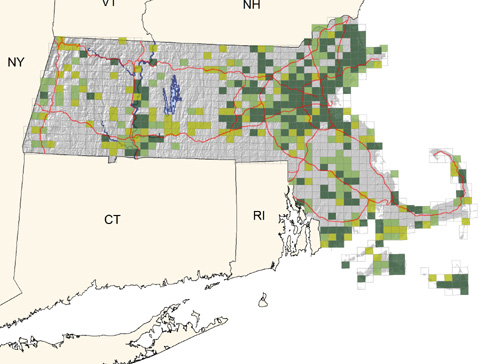Breeding Bird Atlases (BBA)
Find a Bird - BBA1
Breeding Bird Atlas 1 Species Accounts
Ring-necked Pheasant
Phasianus colchicus
Egg Dates
April 1 to August 25
Number of Broods
one; may re-lay if first attempt fails.

This exotic, colorful game bird was introduced to Massachusetts in 1894. Thereafter, the population rapidly increased when numerous releases were made in the wild. Widespread favorable farmland habitat resulted in the pheasant’s establishment from the Berkshires to Cape Cod and the Islands. Today, despite the dwindling of agricultural land, pheasants continue to thrive under suburban conditions, with substantial numbers occurring in many metropolitan areas. Especially high populations occur in the lower Connecticut River valley, Bristol and Norfolk counties, the Islands, and suburban regions in eastern Massachusetts. The high incidence of feeding stations in the latter contributes greatly to maintaining large numbers of Ring-necked Pheasants. It seems probable, given the decline in suitable pheasant habitat, that it is the survivors of releases made each year from state game farms that maintain the feral population.
The cock Ring-necked Pheasant is vocal principally during the breeding season in late March to early April, when he crows and claps his wings to establish a territory of a few acres. The males may fight fiercely for possession of a territory. Nesting begins in early April. Male pheasants are polygamous and will copulate with several hens, leaving the latter to incubate the eggs and rear the young. In areas with a high population, four or more hens may nest within the territory of a single male. When flushed, males give several loud squawks. Females have a quieter queep call.
Pheasant nests consist of little more than crude depressions in the ground in hayfields, orchards, woodland borders, and hedgerows. Clutch size ranges from five to twenty-three (average eleven), and, should the first clutch be destroyed, the hen will generally lay a smaller second set. Eggs are slightly smaller than those of a chicken. The color ranges from pale green to olive brown or even occasionally to light blue. The hen incubates for 23 to 25 days.
Young pheasants are precocial and are able to fly by two weeks of age but remain dependent upon the hen for six to eight weeks. For a short time after the chicks hatch, the hen may resort to a feigned broken-wing display to distract enemies, but, as is typical with all ground-nesting species, there may be heavy losses of eggs and young to a host of marauders including domestic cats. The Great Horned Owl is the most significant avian predator on young and adult pheasants.
In late summer and early fall, as the young reach adult size, broods break up, and the birds separate by sexes into flocks. Bands of hens are generally larger than those of the males. Such groups range for food over an area of 1 or 2 miles. Roosting sites are in small woodlots, swamps, or brush areas, where there is some protection from winter winds.
Map Legend and Data Summary
Atlas 1 data collected from 1975-1979


Note: fairly common in fields at lower elevations; scarcer in hill country
E. Michael Pollack



